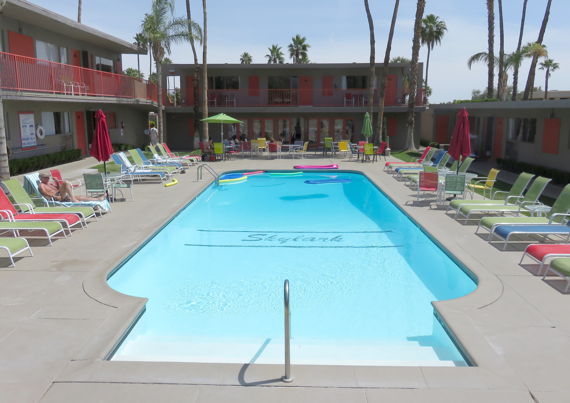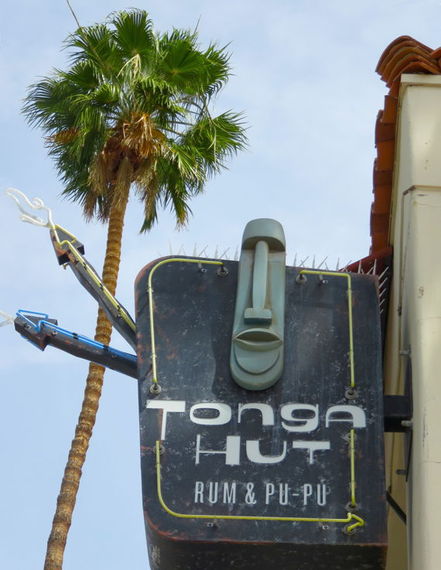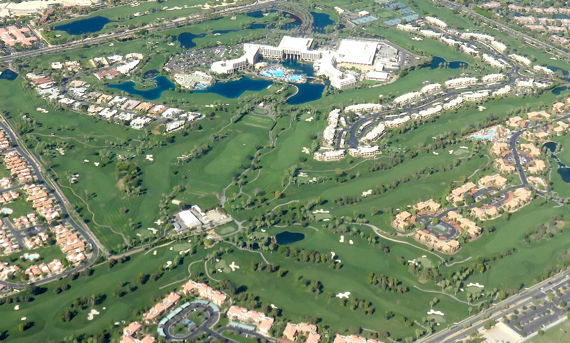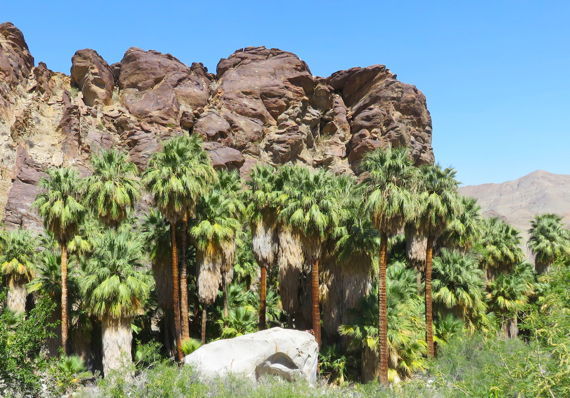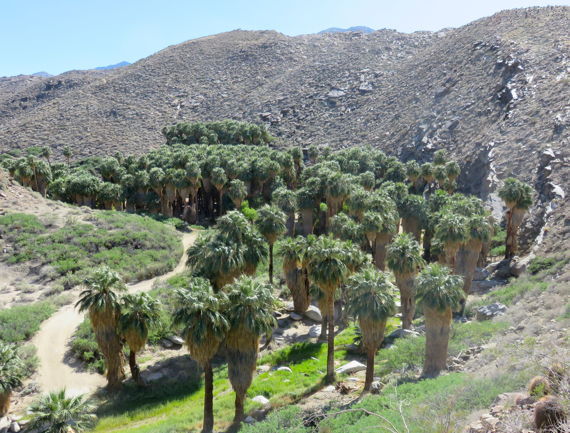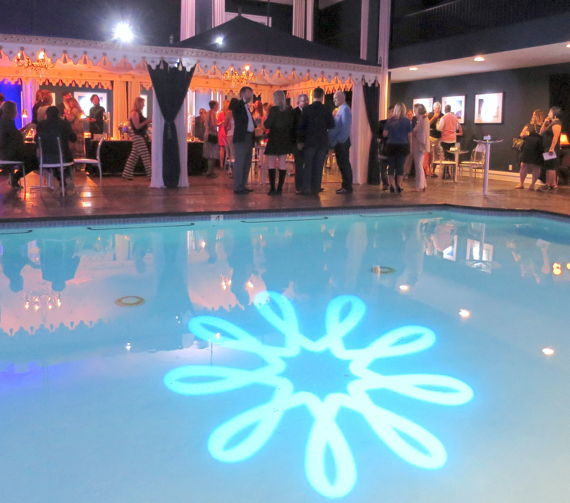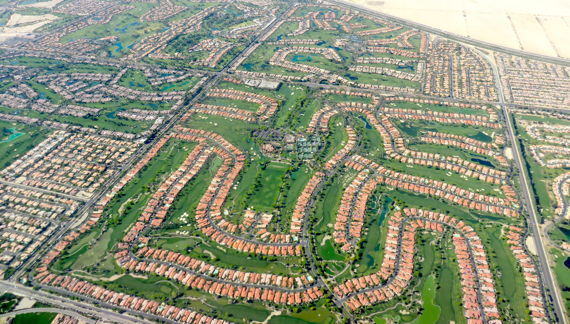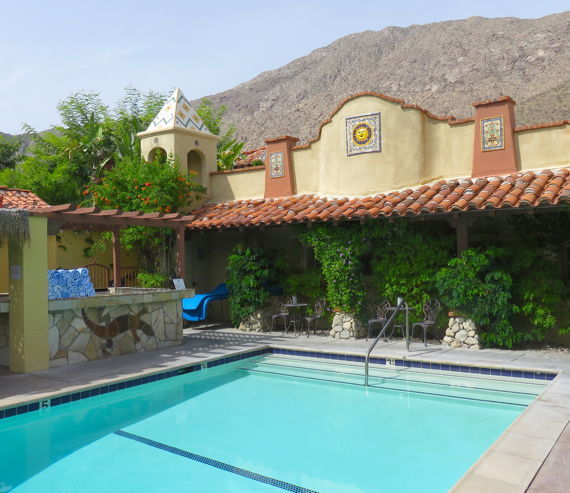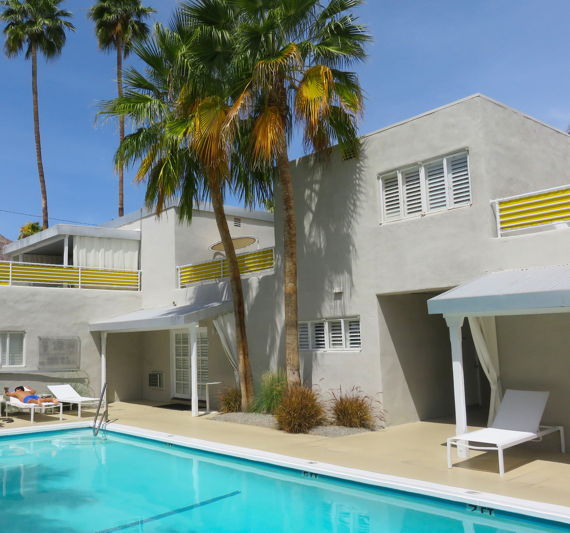When I mentioned to a friend that I had recently visited Palm Springs, he asked, "Which Palm Springs?"
There's only one city in California named Palm Springs, of course, but that magical spot means different things to different people. My friend wondered what Palm Springs meant to me: luxury, nostalgia, golf, nature? Or something else?
As I tried to formulate an answer, I realized that Palm Springs doesn't present just one face to the world; it has seven distinct faces, attracting seven different categories of visitor.
And like many cases of Multiple Personality Syndrome, each of those faces might not even know the others exist.
Palms Springs' unusual combination of themes and personalities is unique in the world. Here, for the first time ever, is a complete inventory of Palm Springs' seven faces.
1. Mid-Century Modern Palm Springs
The phrase "mid-century modern" has in recent years zoomed from the back pages of obscure architectural journals into the mainstream of popular consciousness. But what does the phrase even mean?
Your average hipster will tell you that "mid-century modern" simply means "all that cool stuff from the '50s and '60s," but it's actually a very specific style in the history of architecture and design, evoking sleek lines, glass walls, lots of windows and a light, airy indoor/outdoor feeling that consciously rejects the heavy, busy, claustrophobic spaces of the Victorian era.
The city of Palm Springs began to blossom at the exact moment that the mid-century modern style swept the architecture scene, so the city became the epicenter of the movement, with more mid-century modern buildings per acre than any other town in the world. Since then, Palm Springs has gradually become a place of pilgrimage for hardcore architecture-lovers -- and anyone else who has seen a few episodes of Mad Men and wants to claim a piece of that cool.
To devotees, the designs of visionaries such as John Lautner, William F. Cody, Albert Frey and Donald Wexler didn't merely define a new architectural style; they represented the dawn of a new American lifestyle, one now lost, of casual sophistication, of cocktails on the lanai, of relaxed self-confidence. The obsession with mid-century modern is the desire to reclaim this idealized era.
When touring the town, don't expect a lot of wild, Jetsons-inspired retro-futurism: architectural historians will tell you that the flamboyant motel-and-coffee-shop space-age fantasias are not true "mid-century modern," as most people assume, but rather a distinct (but related) style called "Googie" architecture -- which is much rarer in Palm Springs than true mid-century modern.
The phrase "mid-century modern" was first adopted in the 1950s when the style truly was "modern" and new; the irony is that the name stuck while the decades passed, so that these days "modern" refers to stuff that is certifiably old, completely reversing the meaning of the word.
But whether you're a serious student of design or just bewitched by Rat Pack nostalgia and everything retro and hip, Palm Springs is the place to go.
It's all so overwhelming: where to start?
Well, in truth you could wander around the city at random and stumble upon mid-century modern masterpieces every step of the way, but to get your bearings stop by the Palm Springs Visitor Center (itself in a repurposed world-famous mid-century modern gas station at 2901 North Palm Canyon Drive) and buy its easy-to-follow self-guided tour booklet for five bucks.
Or simply surf over to any of several online lists of buildings; you can even follow your phone by downloading an app with a thorough self-guided tour of every modernist building of note in the entire area.
There are thousands of modernist buildings in and around Palm Springs, far too many to even begin listing in a short overview like this; but for no cost at all, you can download this book-length pdf published by the city government which contains within its pages a comprehensive list, including addresses, of every single historical building in the city, along with context and history for each.
Downtown Palm Springs is bursting with mid-century modern motels and hideaways: true aficionados stay in places like the Orbit In or the Del Marcos Hotel or the Desert Star, all of which create a fully immersive modernist environment with furniture and period decor to match the architecture. Booked up? Try these modernist classics too.
If all this inspires you to revamp your own home into a Mad Men film set, the city's newly designated Uptown Design District, on North Palm Canyon Drive between Alejo Road and Vista Chino, is wall-to-wall boutiques selling furniture, crafts, housewares and art almost all inspired by what is now called the "Desert Modernism" ethos.
The city's annual Modernism Week functions as the definitive convention for modernism-heads globally, with symposia, cocktail parties and behind-the-scenes access not available at any other time. 2016's event is scheduled for February 11 to 21, so reserve tickets now as things tend to sell out -- 50,000 people attended last year.
2. Luxury Resort Palm Springs
Indulgent. Luxury. Pamper. These are some of the code words used by marketing departments to notify a certain upscale clientele that a hotel or resort is the best of the best. But the marketers have run out of words for the extravagance that awaits jetsetters in Palm Springs. Want to relax like royalty? Price no object? High-end, luxuriant, unabashedly opulent resort spas dot the valley around Palm Springs like emeralds in a jewel box.
There are numerous "Top Ten" (and even Top Fifty) lists awarding accolades to resorts up and down the Coachella Valley -- so many that keeping them all straight can be confusing. But I've done the hard work for you: the following list identifies (in no particular order) the hotels, spas and resorts that most frequently win the best-of-the-best lists and review rankings. Pick and choose your favorite style or ambience, and dive in.
La Quinta Resort & Club
49499 Eisenhower Dr., La Quinta.
The original Palm Springs-area resort. 45 acres. Suites with private pools. Five golf courses; rated #1 golf resort in the nation. Recently upgraded; everything is new. Buzzword: "Quintessential."
Ritz-Carlton Rancho Mirage
68900 Frank Sinatra Dr., Rancho Mirage.
Private, exclusive retreat in rugged desert hills. Spacious rooms and fine dining all with panoramic views. Multi-level deluxe spa with local herbal treatments. Huge pool. Hiking trails originate on property. Buzzword: "Exquisite."
JW Marriott Desert Springs Resort & Spa
74-855 Country Club Dr., Palm Desert.
450 acres of ostentatious opulence; visible from outer space. Interior waterfalls; lagoons with gondolas. Ballrooms, Turkish-style "hammam" steam rooms, nationally acclaimed golf courses and 18-hole putting-only course. Buzzword: "Utmost."
Riviera Palm Springs Resort & Spa
1600 North Indian Canyon Dr., Palm Springs.
Legendary '60s mid-century modern Rat Pack hangout, completely refurbished. World's swankiest hipster motel. Buzzword: "Glam."
Omni Rancho Las Palmas Resort & Spa
41000 Bob Hope Dr., Rancho Mirage.
240 acres: bigger than some small nations. On-site waterpark with 450-foot swimming river. Palm-lined golf courses. 25 tennis courts. Buzzword: "Paradise."
Miramonte Resort & Spa
45000 Indian Wells Lane, Indian Wells.
Eleven acres of luxury, arranged like a Mediterranean village. On-site spa "The Well" often wins polls and awards as the valley's best. Buzzword: "Sophistication."
Westin Mission Hills Golf Resort & Spa
71333 Dinah Shore Dr., Rancho Mirage.
Rated one of top golf resorts in North America. Vast grounds. Six on-site restaurants. Family- and pet-friendly. Buzzwords: "Ultimate oasis."
Parker Palm Springs
4200 E. Palm Canyon Dr., Palm Springs.
Focus on avant-garde design and retro-trendy chic. Petanque court, croquet lawn, pastis cocktails. Post-ironic elegance. Where the beautiful people go to see and be seen. Buzzword: "Seductive."
Renaissance Indian Wells Resort & Spa
44400 Indian Wells Lane, Indian Wells.
Two top-ranked on-site championship golf courses. Every imaginable amenity, from valet dry-cleaning to free charging stations for electric cars. Buzzword: "Majestic."
Hyatt Regency Indian Wells Resort & Spa
44600 Indian Wells Lane, Indian Wells.
Two world-class golf courses on hotel grounds. Seven swimming pools. Spa and spa-within-a-spa. Buzzword: "Ultrachic."
If you still cant find the perfect match in this list for your personal style, there are dozens more luxury resorts to choose from in every corner of the Palm Springs area.
3. Nature Lovers' Palm Springs
Long before there were resorts and swimming pools or even buildings at all in the area, Native Americans settled here amidst the lush palm-tree oases which grew around natural freshwater springs (hence the name "Palm Springs"). When the first 20th-century tourists showed up, they too were drawn to the naturally occurring palm springs, which is the very reason why this area became a health resort. Amazingly, some of these palm groves and year-round springs are still here, almost unchanged from when they were first discovered. But they're not easy to find -- unless you know where to look. Hidden in mountain ravines south of downtown Palm Springs, the area now called simply "Indian Canyons" disguises behind its generic name one of the most unusual natural wonders in the state: thriving forests of glorious palm trees in the middle of a bone-dry, furnace-hot rocky desert.
To reach Indian Canyons simply take Palm Canyon Drive -- the main drag through downtown Palm Springs -- all the way south until it finally snakes into the mountains, where you'll encounter a tollbooth and a $9 admission fee. The ranger will hand you a trail guide to the three canyons in this part of the Agua Caliente tribe's reservation.
Andreas Canyon, the first of the three, is impossibly picturesque, a pristine mirage-like oasis of skirted palm trees flanking a spring-fed creek. A two-mile hiking trail wends through the oasis and along the creek up a hidden canyon; the return half of the hike reveals views of a valley too perfect to seem natural, as if it must be part of a cleverly designed theme park.
Murray Canyon, a short hike away along an adjacent trail, has a similarly palmly landscape, but is less crowded on weekends.
But it's not until you reach Palm Canyon that you truly appreciate why this area was considered sacred. The word "oasis" hardly suffices to describe the dense forest of palm trees in the most unlikely of spots, a desolate mountainscape that often tops one hundred degrees and can sometimes hit 115. Even so, the natural underground springs feed what is now the world's largest fan palm oasis.
There is a fourth canyon on the reservation, Tahquitz Canyon, much closer to downtown at the western end of Mesquite Avenue, but it has its own separate admission fee ($12.50) and has only a few palms, so it isn't nearly as impressive. If you simply want to experience the raw desert on foot, there are several free hiking trails leading west and south from the built-up urban areas of Palm Springs -- such as the Skyline Trail which starts at the back corner of the parking lot for the Palm Springs Art Museum (on Museum Drive), or the Goat Trails, starting from Palm Hills Drive at East Palm Canyon Drive at the south end of town, among many others.
When hiking in Palm Springs, always go prepared (water, hat, sunscreen, cell phone, etc.), as the heat can be brutal.
Hardcore nature-lovers drive an hour to Joshua Tree National Park (just north of the Coachella Valley), over a thousand square miles of stark high-desert wilderness.
4. Celebrity Culture Palm Springs
While much of Palm Springs' glory rests on its connection with stars from the Golden Age of Hollywood, the town's worst-kept secret is that it's still a premiere star-magnet; more celebrities are sneaking away to Palm Springs right now than ever before.
Forget about the Hollywood Walk of Fame or touring "homes of the stars" in Beverly Hills. If you are a celebrity-hound, you have more of a chance to brush up against fame in Palm Springs than you do in Los Angeles.
But celebrities go to great lengths to avoid their fans. Here are a few tips for rubberneckers and amateur paparazzi.
Go to the annual festivals that bring the glitterati to the area.
The Palm Springs International Film Festival is not quite the Oscars, but it does function as a mini-Cannes, and it is now the event where studios unveil the top international contenders for each year's Best Foreign Language Film; as a result, the festival attracts international celebrities as well as our homegrown Hollywood stars. Last year the red carpet featured Benedict Cumberbatch, Julianne Moore, Eddie Redmayne, Reese Witherspoon, Robert Duvall, Rosamund Pike and Richard Linklater, among many others; the year before that had Julia Roberts, Tom Hanks, Meryl Streep, U2, Matthew McConaughey and Sandra Bullock, to name just a few. Who will show up for 2016? Be there, January 1 to 11.
The Coachella Valley Music and Arts Annual Festival -- usually shortened to just "Coachella" -- has evolved to become the nation's annual Woodstock, where the world's bestselling musical acts and sizzling newcomers convene for two weekends every April at the Indio Polo Club. This year featured everyone from David Guetta to AC/DC to Azealia Banks to Steely Dan to Drake to every act that will be just as famous two years from now.
The BNP Paribas Open attracts every tennis legend currently active: last year's roster of Roger Federer, Rafael Nadal, Serena Williams, Maria Sharapova and everyone else in the top fifty are likely to repeat this year.
Each of these festivals are surrounded by myriad parties and side events; keep your eyes and ears open!
Haunt the celebrity hangouts.
All these movie stars, music VIPs and tennis legends have to sleep and eat and play somewhere while they're in town. The trick for fame-chasers is to learn where the celebrities hang out while they're performing at the events listed above -- or even while they're just on vacation. Most hotels have a "no tell" policy, but gossip sites have spotted superstars and supermodels at exclusive inns like the Avalon (formerly the Viceroy) and Korakia Pensione (though, now that the word is out, they could very well decamp for elsewhere).
If you've got Google skilz, you can search the gossip sites for "Palm Springs" to see where the stars are currently being spotted around town. For example, John Travolta recently popped up at Melvyn's Restaurant, while Gigi Hadid was spotted at the Parker Palm Springs; you get the idea.
Generally speaking: the pricier the shop, restaurant or hotel, the more it keeps out the hoi polloi, and therefore the more appealing it is to celebrities.
5. Golfing Palm Springs
As your plane descends into the Palm Springs airport, the view out the window reveals the Coachella Valley as one vast golf course extending off to the horizon. It's a rolling sea of emerald and mint and jade carpets as far as the eye can see.
For your convenience, luckily, it's not all one endless course, but no less than 124 individual golf links, many of them world-class, interlocked so tightly from Palm Springs down to La Quinta that the non-golf remnants of the landscape seem like an afterthought.
Golfers the world over regard any Palm Springs vacation as a holy pilgrimage to a duffer's paradise. Even the humblest of the Coachalla Valley's public courses feels like sacred ground; the area's exclusive country clubs each count as a once-in-a-lifetime experience. That is, until you shank your approach into a lake. %#&@$∞!
Golf is so dominant here that non-golfers sometimes feel like second-class citizens. But remember: golf-related tourism has become the primary engine which drives the region's economy, so each of the other six "faces" of Palm Springs discussed here is to some degree made possible by the broad-spectrum revenue spurred by golfing.
6. Vintage Hollywood Palm Springs
Hollywood's obsession with Palm Springs did not begin with Rat Pack-era celebrities. Rewind the clock back through the 1930s and '20s to discover that, even in the era of Charlie Chapin and Rudolph Valentino, Palm Springs was already the playground of the stars. And the buildings from this golden age -- many of which still exist to this day -- have a magical charm of their own, with whitewashed irregular adobe walls, red tile roofs and wooden beams. These Mission-style and adobe Spanish gems are nowadays sometimes overlooked in the mad stampede for everything mid-century modern, but they represent a lost age that can't be found anywhere else, not even in Hollywood itself.
When Palm Springs was still not much more than a little resort village, much of the action centered around an area just west of downtown now dubbed the Historic Tennis Club Neighborhood. In this small area west of Belardo Road between Ramon Road and Tahquitz Canyon Way, quaint resort hotels, bungalow courtyards and private retreats attracted the Tinseltown elite of '20s and '30s. Casa Cody, for example, at 175 S. Cahuilla Rd., was built in 1918 by Buffalo Bill's cousin Harriet; the "California hacienda" style cottages remain open today as the oldest (and most charming) place to stay in the city. Around the corner, the Arenas Gardens Hotel, at 529 West Arenas Road, is a 1920s white stucco treasure where silent screen legend Gloria Swanson escaped the pressures of being the most famous woman in the world. A block away at 458 West Arenas, Andalusian Court preserves every detail of its Spanish Revival and Arts and Crafts design, with vines climbing over rough adobe walls to curved tile roofs; guest rooms have heavy wooden beams and rustic fireplaces.
But these are just a tiny sampling; every few steps reveals another surprise. The best self-guided tour of '20s and '30s Palm Springs can be accessed online at no cost -- although it takes a couple minutes. First you must sign up for a free online membership with the Palm Spring Preservation Foundation, and once you've joined, you can download their essential booklet "A Guide to the Designated Class 1 Historic Sites of Palm Springs," which gives you the low-down on all the oldest and most beautiful buildings in town.
Of course the transition from classic "Mission Revival"-style architecture to mid-century modern did not happen overnight, and during the '30s and '40s there was a great deal of overlap as one style evolved into the other. In fact many buildings which seem at first glance to have an undeniable old-school 1930s glamor turn out to be technically classified as "modernist" -- such as the famous Movie Colony Hotel at 726 North Indian Canyon Drive, designed way back in 1935 by Albert Frey, who was one of the founding fathers of desert modernism.
7. PaLGBTm Springs
Hollywood stars of yore fled to Palm Springs to escape the prying eyes of paparazzi and scandal-mongers; the resort quickly became known among the cognoscenti as a secluded getaway where celebrities living secret lives could party and play with abandon behind the high walls of exclusive hotels and estates. And thus it was only natural that the area evolved into a mecca for the gay lifestyle as over the decades word spread that Palm Springs was the place where the beautiful people dropped their inhibitions.
Palm Springs now has more gay-themed hotels and resorts than any other city in the world, a fact little known to the general public.
The blocks of Arenas Road just east of Indian Canyon Drive are jokingly called "the Castro District of Palm Springs" for their strip of gay-friendly shops, restaurants and nightclubs.
Palm Springs also plays host to LGBT festivals and events throughout the year; biggest among these are the White Party, a legendarily hedonistic three-day weekend each April, and The Dinah, also in April, billed as "the world's largest lesbian event."
(All photos © Copyright 2015 by Kristan Lawson.)
